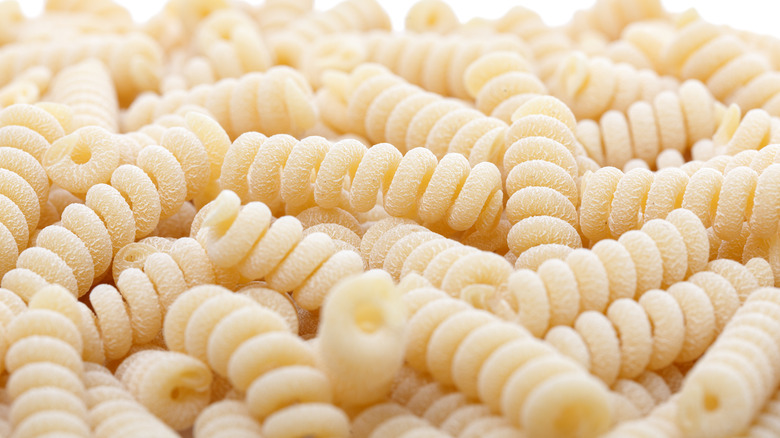Fusilli Vs Rotini: What's The Difference?
Pappardelle, fettuccine, macaroni, oh my! There are so many dangerously delicious pasta recipes out there. From homemade mac n' cheese to baked spaghetti, pasta is one of the easiest and most beloved meals to cook at home. With such a wide variety of pasta shapes and sauces, the cooking possibilities with this staple carb are endless. But with over 350 different types of pasta from around the world, sometimes it can be hard to distinguish between what's what.
Both equally fun to say, fusilli and rotini are two twisted-shaped pasta types that add a unique layer of texture to any pasta dish. Due to their similar shape, fusilli and rotini repeatedly get confused with one another. In fact, many people even believe that fusilli and rotini are one in the same. While at first glance fusilli and rotini appear to be nearly identical, there are small differences between the two corkscrew-shaped pastas. According to Foodsguy, while fusilli is made of flat strands of pasta that are later twisted into curly, spring-like shapes, rotini noodles are extruded into a spiral shape and have a slightly smaller and tighter twist to them.
What is fusilli?
Fusilli (foo-zee-lee) is a thick, short-cut Italian pasta made from semolina flour. Originating in the center-south of Italy, this helical pasta's name is derived from the word "fuso," meaning spindle, as this pasta is traditionally made using a spindle rod to form its corkscrew shape. Fusilli is highly versatile in the kitchen, as its twists and curves are perfect for trapping both thin and thick sauces — from hearty meat sauces to rich and creamy sauces. This spiral-shaped pasta can also be baked into casseroles, used in pasta salad, and added to soups. The pasta-bilities are endless for this multipurpose pasta.
Itching to use up a box of fusilli pasta in your pantry? Try a one pot creamy French pasta bake recipe. Delicious, cheesy and comforting, this is the perfect dish for a large crowd and is bound to make everyone feel right at home.
What is rotini?
In contrast, rotini (roh-tee-nee) is a short-cut, corkscrew-like pasta made from semolina flour that originated in Northern Italy. Each noodle is typically two inches in length. Similar to fusilli, rotini, meaning "twists," is known for its signature spiral shape, and its sauce-hugging grooves complement light tomato sauces, dairy-based sauces, and oil-based sauces. If you have a box of rotini pasta handy, a fantastic pasta primavera recipe is perfect for veggie lovers and will satisfy any carb cravings.
Popular with children, there is also a multi-color version of this pasta called tri-color rotini. Each box of tri-color has a combination of pasta that varies between green, red, and plain yellow pasta. While the plain pasta is simply made from the same durum semolina wheat as the regular rotini pasta, the green pasta gets its color from dehydrated spinach powder, and the red pasta gets its color from dehydrated tomato or beet root powder.
Can rotini be substituted for fusilli?
Due to their extremely similar spiral-shape, rotini makes a great substitute for fusilli, as they are near duplicate pasta types. The twisty curves of both types of pasta are perfect for adhering to both thin and thick meat, cream, and herb sauces, including pesto.
If you are struggling to find either fusilli or rotini at your local grocery store, don't panic! Gemelli pasta also makes a wonderful substitute for both fusilli and rotini. According to Barilla, "Gemelli is a simple shape of two strands of pasta twisted together." Like both fusilli and rotini, the twisted shape of Gemelli pasta helps it absorb the flavor of sauces while still remaining firm and "al dente."
While the abundant varieties of pasta can seem a bit daunting, when you think about it, it all provides us with rich opportunities to explore and experiment — including explorations of both fusilli and rotini.



